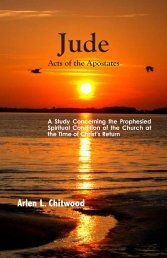Signs in John's Gospel - The Lamp Broadcast
Signs in John's Gospel - The Lamp Broadcast
Signs in John's Gospel - The Lamp Broadcast
Create successful ePaper yourself
Turn your PDF publications into a flip-book with our unique Google optimized e-Paper software.
74 SIGNS IN JOHN’S GOSPEL<br />
In the first chapter, this birth is seen hav<strong>in</strong>g to do with <strong>in</strong>dividuals<br />
be<strong>in</strong>g brought forth completely apart from anyth<strong>in</strong>g connected<br />
with man, through a work associated solely and completely with God:<br />
“…not of [‘out of’] blood, nor of [‘out of’] the will of the flesh, nor<br />
of [‘out of’] the will of man, but of [‘out of’] God” (v. 13).<br />
And this Div<strong>in</strong>e work, textually, has to do with those to whom<br />
Christ came 2,000 years ago — the Jewish people. Through receiv<strong>in</strong>g<br />
the Christ, believ<strong>in</strong>g, the Jewish people were given the “power<br />
[‘right’] to become the sons of God [Gk., ‘children of God’]” (v. 12).<br />
<strong>The</strong>n <strong>in</strong> the third chapter, the words, “from above,” are used<br />
relative to this birth, with the subject matter be<strong>in</strong>g signs, and the<br />
proffered k<strong>in</strong>gdom (vv. 1-3). And, aga<strong>in</strong>, the Jewish people are <strong>in</strong> view.<br />
Nicodemus, a Pharisee, a teacher among the Jewish people, had<br />
come to Jesus “by night.” Nicodemus referenced the signs be<strong>in</strong>g<br />
performed, acknowledg<strong>in</strong>g that he and others (apparently other<br />
religious leaders) knew that the One perform<strong>in</strong>g these signs <strong>in</strong> the<br />
presence of the people could only be “a teacher come from God.”<br />
In His response, Jesus rema<strong>in</strong>ed completely with<strong>in</strong> the scope of the<br />
subject at hand, though He moved beyond the thought of signs and<br />
dealt with the heart of the matter. Jesus immediately dealt with the<br />
necessity of the birth from above (previously <strong>in</strong>troduced <strong>in</strong> John’s gospel<br />
as a birth out of God [1:13]) — an absolute necessity if an <strong>in</strong>dividual<br />
were to “see” that to which the signs po<strong>in</strong>ted, the k<strong>in</strong>gdom of God.<br />
Dur<strong>in</strong>g Moses and Joshua’s day, and dur<strong>in</strong>g Elijah and Elisha’s<br />
day, signs had been manifested <strong>in</strong> the presence of the Jewish people<br />
<strong>in</strong> connection with the Old Testament theocracy. In this respect,<br />
draw<strong>in</strong>g from the Old Testament Scriptures, a manifestation of<br />
signs surround<strong>in</strong>g Christ’s first com<strong>in</strong>g, of necessity, could only have<br />
had to do with the proffered k<strong>in</strong>gdom (ref. Chapter III of this book).<br />
Nicodemus’ query and Jesus’ response emanated from a background<br />
and sett<strong>in</strong>g of this nature. Though Nicodemus may have<br />
understood the reason for signs and that which they portended,<br />
he didn’t understand what Jesus meant when He called attention<br />
to the birth from above as a necessity for see<strong>in</strong>g the k<strong>in</strong>gdom. His<br />
thoughts shifted from that of “signs” to Jesus’ statement concern<strong>in</strong>g<br />
the birth from above (vv. 3, 4), and Jesus then went on to expla<strong>in</strong>



